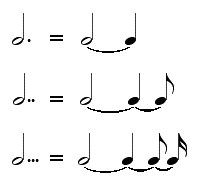Rhythm and Meter
Rhythmic Organization
1.
The Beat = A span of time that recurs regularly. The Pulse. In much of western music the beat value is identified as a quarter note. Less frequently but certainly not uncommon, is a beat value of a half or eigth note.
a. Duple meters are divisions of 2 from Whole to 64th etc.
Whole note = 4 quarters (or 2 half notes)
Half note = 2 quarters
Quarter note = 1 quarter
2 Eigth notes = 1 quarter
4 Sixteenth note = 1 quarter
8 Thirtysecond note = 1 quarter
Etc…

b. Triple Meters are Divisons of 3 from Whole to 64th etc.
Whole note = 6 quarters (or 3 half notes)
Half note = 3 quarters
Quarter note = 1 quarter
3 Eigth notess = 1 quarter
6 Sixteenth notes = 1 quarter
12 Thirtysecond notes = 1 quarter
Etc…

c. Dotted notes = original value(a) +1/2 previous . It is also possible to have double dotted note values = original value(a) + 1/2 previous+1/2 previous

d. Ties combine note values into a single duration.
2.
Tempo = Pace of the music as determined by the beat NOT the note value. Note values therefore move at relative REALTIME durations. That is, a quater note at a slow tempo will last longer than a quarter note at a fast tempo.

3+4
Meter & Metrical Accent= A repetitive pattern that combines accented and unaccented beats. When the accented "strong" beat is on the first of every two beats the meter is duple. If the accented "strong" beat is on the first of every three beats the meter is triple
5
Time Signature = Indication of Meter. Appears after the key signature.
a. Top = How Many
b. Bottom = What Kind
c. Ex. 4/4 = four beats per measure + quarter takes the beat.
d. Ex. 6/8 = six beats per measure + Eighth takes the beat.
e. Ex 3/2 = three beats per masure + Half takes the beat.
f. Compound Meters are thought of as combinations of meters grouped together
g. Ex. 5/8 = three + two beats per measure + Eighth takes the beat.
6
Rhythmic Accent = An emphasis that lies within a metrical accent.
a. Syncopation = the rhythmic accent contradicts the meter or a rhythmic accent occurs on a metrically weak beat.
b. Hemiola occurs when shifted accents appear to change the meter. Ex. 3 sets of 2 quarters = 2 bars in ?
Rhythm and Dissonance Treatment
9. Dissonance, duration & Accent
a. Dissonances tend to occur in notes of relatively brief duration and in metrically unaccent places. Of course it is possible to have accented passing or neighbor dissonances and appoggiaturas. (There are two common definitions of The appoggiatura. Many early classical composers would avoid writing an strong dissonance by writing a grace note prefixed to a principal note. Usually it is an indication that the principal note is to be divided resulting in a dissonance on the relatively strong beat. As well, a more liberal definition includes any accented incomplete neighbor)
10. Suspensions
a. When a dissonance is shifted or extended to a strong beat.
10. Anticipation
a. When a tone is shifted out of its normal position before the beat.

